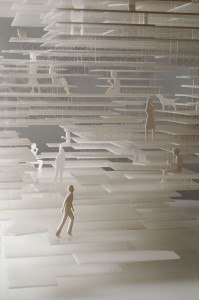Text _ Primitive Future, Sou Fujimoto
Case study _ Wall House, FAR
It can be argued that first architecture was a shelter from natural environment. On the contrary, recent architecture tends to investigate in more depth how to be one step closer to the nature. Nevertheless, we don’t want to expose ourselves to it completely, but rather find a way to control it, or find a right measurement of how much of it we want to let in our closed and secure shelter.
In the process of addressing this topic, the most relevant factor seems to be the envelope around inner space, the place where inside and outside are closer than anywhere else, but they never seem to meet. Simply a barrier, clear in protective role and appearance.
The Wall House, designed by the FAR architects (Frohn and Rojas), directly explores possibilities of an envelope, simply referring to it as a wall. By dividing the wall into different layers, they are trying to create space that gradually opens to the nature and merges with it. Although, it can not be doubted that spaces created inside provide different atmospheres and levels of protection, it is still a barrier. When inside the house, one can feel and touch divisions between these spaces. The last layer towards nature is thin and transparent, but still a closed surface. This wall is successful in the environmental terms, manifesting very strong relationships with natural factors, and it does make outside part of the inside. On the other hand, the envelope itself remains strongly defined as in the case of a shelter, however without providing spaces that are really somewhere in-between, spaces that are hard to argue whether they belong to the inside or outside.
These spaces in-between are further examined in Sou Fujimoto’s text Primitive Future. Fujimoto argues that the envelope represents a border between the inner and outer space. According to the author this border should be blurred towards nature, as a place where outside and inside merge, where there is no clear barrier between the house and the city. Aside from the theoretical concepts proposes in the text, this type of architecture is further realized through his projects, the N house in particular. In this house spaces are merging, and it is not possible to say in which space you are currently in, or when one starts and other begins. The absence of strongly defined barrier, allows for the matter of moment and the environmental factors to create and shape the space and define its borders. It is in-between. There are no clear divisions, solely gradation. By merging different environments, Sou Fujimoto expresses a lot of different relationships in the space, and they can be sensed with all of our senses. Apart from the environmental and positional factors, individual experience should also be taken into account as something that makes gradations and defines envelope around space. The existence of many intangible relations in this border between inner and outer space, induce the disappearance of the border. The more senses an architecture wakes in us, the more advanced it is.
Moreover, Sou Fujimoto also refers to the cave, and further investigates its importance for the development of his ideas in architecture. This relates to the topic that I am particularly interested in, and would like to pursue further research on. He describes cave as space that exists regardless of human activity, but at the same time, by inhabiting it, humans shape it in a manner that they find appropriate configurations for the execution of certain activities. Expanding on Fujimoto’s initial idea of making accidental spaces, I am wondering whether the design based solely on the logic of functionality is even able to control the way people inhabit spaces. As much as we, architects, think we have control over activities by creating limits to certain spaces, we are not able to control individuals who are driven by their own experience and emotions. People tend to choose their spot in every space they enter at the same manner as they chose it in the cave. Are we then ultimately designing the cave every time without knowing it? If that is the case, we should perhaps think in terms of designing the cave, and consequentially shift the focus from the question of functionality towards thinking in terms of primal instincts and intuition. Maybe only then we would be able not to design a cave.

